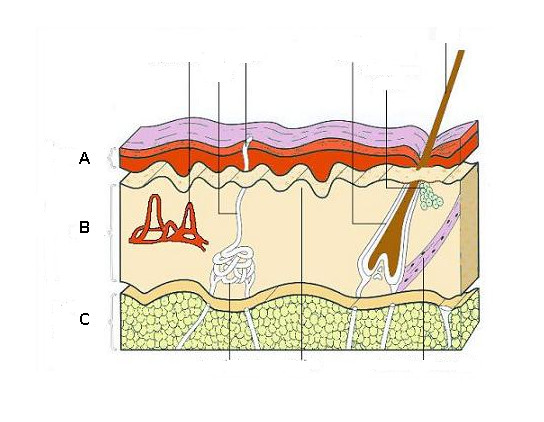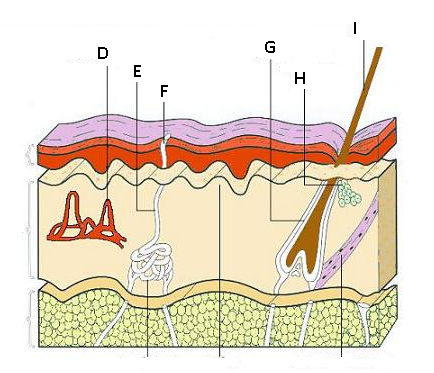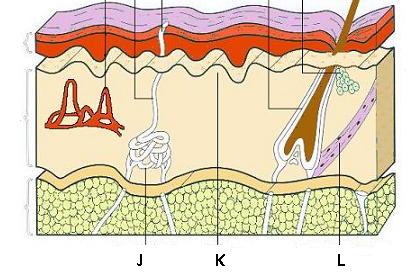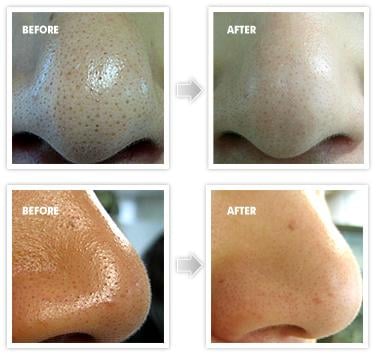Dermatology & Cosmetics

Revision Quiz for Queensland Multi-strand Science syllabus,
Unit 8 - Cosmetics and Dermatology
- 1.
The term cosmetics is derived from
- A.
The Latin word for 'painted face' meaning to cover or improve the appearance of ones skin.
- B.
The Greek word for 'adornment', meaning to improve the beauty or health of the skin.
- C.
The Egyptian word for 'soft skin', from the tradition of soaking in milk baths to improve the complexion.
- D.
The Hebrew word for health and cleanliness, references made to this in the Old Testament.
Correct Answer
B. The Greek word for 'adornment', meaning to improve the beauty or health of the skin.Explanation
The correct answer is the Greek word for 'adornment', meaning to improve the beauty or health of the skin. This is because the term cosmetics refers to products that are used to enhance or improve the appearance of the skin, and the Greek word for 'adornment' aligns with this purpose.Rate this question:
-
- 2.
Which of the following is not a stipulation for all cosmetics manufactured or imported into Australia, as outlined by the National Health and Medical Research Council (NHMRC)
- A.
Ingredients are listed in descending order, calculated either by mass or volume
- B.
A manufacturer may apply for permission to refer to a particular ingredient as "other ingredient" where it can prove the substane is a trade secret and will be kept secret.
- C.
A manufactuer may use the phrase "may contain..." on products manufactured on the same equipment as other cosmetic products.
- D.
Ingredients must be listed in English in a clear and legible manner.
Correct Answer
C. A manufactuer may use the phrase "may contain..." on products manufactured on the same equipment as other cosmetic products.Explanation
A manufactuer may use the phrase "may contain..." on a range of very similar products - for instance eyeshadows which are identical except for the colours used.Rate this question:
-
- 3.
The names of the following structures in order (A, B, C) are;
- A.
Subcutaneous fat, epidermis, dermis
- B.
Subcutaneous fat, dermis, epidermis
- C.
Epidermis, subcutaneous fat, dermis
- D.
Epidermis, dermis, subcutaneous fat
- E.
Dermis, epidermis, subcutaneous fat
Correct Answer
D. Epidermis, dermis, subcutaneous fatExplanation
The correct answer is "epidermis, dermis, subcutaneous fat" because the epidermis is the outermost layer of the skin, followed by the dermis which is the middle layer, and then the subcutaneous fat which is the deepest layer.Rate this question:
-
- 4.
The names of the following structures in order (D, E, F, G, H & I) are:
- A.
Capillaries, sweat duct, pore, hair follicle, sebacious gland & hair
- B.
Sebacious gland, sweat duct, hair follicle, pore, capillaries & hair
- C.
Capillaries, pore, hair follicle, sweat duct, sebacious gland & hair
- D.
Pore, capillaries, sweat duct, hair, sebacious gland & hair follicle
Correct Answer
A. Capillaries, sweat duct, pore, hair follicle, sebacious gland & hairExplanation
The correct order of the structures is capillaries, sweat duct, pore, hair follicle, sebaceous gland, and hair.Rate this question:
-
- 5.
The names of the following structures in order (J, K & L) are:
- A.
Arrector pilli muscle, papilla, sweat gland
- B.
Sweat gland, papilla, arrector pilli muscle
- C.
Arrector pill muscle, sweat gland, papilla
- D.
Papilla, sweat gland, arrector pilli muscle
Correct Answer
B. Sweat gland, papilla, arrector pilli muscleExplanation
The correct order of the structures is sweat gland, papilla, and arrector pilli muscle. The sweat gland is responsible for producing sweat, which helps regulate body temperature. The papilla is a small projection on the surface of the skin that contains blood vessels and nerve endings. The arrector pilli muscle is a small muscle attached to hair follicles, which contracts and causes the hair to stand up when we are cold or experiencing certain emotions.Rate this question:
-
- 6.
What causes blackheads to form?
- A.
Dirt on the skin becomes trapped, clogging up the pores, giving them a dark (black) appearance.
- B.
Overproduction of oil from the sebacious glands reacting with bacteria, which hards and blocks the follicles, oxidising to give a dark (black) appearance
- C.
Oil and grease from overexposure to oils in atmosphere becoming trapped in the sweat glands, oxidising to give a dark (black) appearance.
- D.
Hair follicle reacting with bacteria and becoming infected and forming a pustule, clogging the follicle.
Correct Answer
B. Overproduction of oil from the sebacious glands reacting with bacteria, which hards and blocks the follicles, oxidising to give a dark (black) appearanceExplanation
Blackheads form when there is an overproduction of oil from the sebaceous glands. This excess oil combines with bacteria on the skin and blocks the hair follicles. The trapped oil and bacteria then oxidize, causing them to darken and give the blackhead its characteristic appearance.Rate this question:
-
- 7.
Which of the following is not a recommendation for healthy skin and acne prevention:
- A.
Eat healthy foods with lots of fresh foods.
- B.
Exercise in moderation.
- C.
Clean face several times a day with a low pH astringent, removing bacteria and oils from face.
- D.
Wear SPF30+ sunscreen when outdoors
Correct Answer
C. Clean face several times a day with a low pH astringent, removing bacteria and oils from face.Explanation
Whilst the removal of bacteria from the skin can reduce occurence of bacteria, the stripping of oils from the face will result in the sebacious glands overproducing oil in compensation for those lost.Rate this question:
-
- 8.
The pH range of skin is:
- A.
3.5 - 9
- B.
4.5 - 10
- C.
6.5 - 11.5
- D.
4 - 6.5
Correct Answer
D. 4 - 6.5Explanation
The pH range of skin is 4 - 6.5. This range indicates that the skin is slightly acidic, which helps to maintain its natural barrier function. The acidic pH of the skin is important for protecting against harmful bacteria and maintaining the skin's moisture balance. If the pH of the skin becomes too alkaline or too acidic, it can disrupt the skin's natural functions and lead to various skin issues such as dryness, sensitivity, or acne. Therefore, it is important to use skincare products that are pH-balanced to maintain the health of the skin.Rate this question:
-
- 9.
If my unprotected skin starts to burn after 7 minutes, after what period of time will it begin to burn if I apply SPF15+ sunscreen.
- A.
22 minutes
- B.
35 minutes
- C.
1 hour, 5 minutes
- D.
1 hour, 45 minutes
Correct Answer
D. 1 hour, 45 minutesExplanation
If the unprotected skin starts to burn after 7 minutes, applying SPF15+ sunscreen would increase the time it takes for the skin to burn. SPF15+ sunscreen provides moderate protection against the sun's harmful rays. The higher the SPF, the longer the protection lasts. Since the skin starts to burn after 7 minutes without protection, applying SPF15+ sunscreen would extend the time it takes for the skin to burn. Therefore, it would take 1 hour and 45 minutes for the skin to start burning if SPF15+ sunscreen is applied.Rate this question:
-
- 10.
Melanin is...
- A.
Found in the cornified layer and gives skin it's elasticity
- B.
Found in the granular layer and synthesises vitamin D
- C.
Found throughout the dermis and is responsible for pigmentation of the skin
- D.
Found in the germinative layer and produces new cells for the epidermal layer
Correct Answer
C. Found throughout the dermis and is responsible for pigmentation of the skinExplanation
Melanin is a pigment found throughout the dermis, which is responsible for the pigmentation of the skin. It gives color to the skin, hair, and eyes. Melanin is produced by melanocytes, specialized cells found in the skin. The amount and type of melanin determine the color of an individual's skin. It also helps protect the skin from the harmful effects of the sun's ultraviolet (UV) rays.Rate this question:
-
- 11.
What is the function of the sweat gland?
- A.
Releases oily secretions on to the surface of the skin to prevent loss of moisture
- B.
Maintain moisture on the skin surface to provide a medium for the healthy growth of bacteria
- C.
Provide fluid necessary for evaporative loss from the body
- D.
Release excess water and salts from the tissue
Correct Answer
D. Release excess water and salts from the tissueExplanation
The sweat gland is responsible for releasing excess water and salts from the tissue. This helps regulate body temperature by cooling the body through evaporation.Rate this question:
-
Quiz Review Timeline +
Our quizzes are rigorously reviewed, monitored and continuously updated by our expert board to maintain accuracy, relevance, and timeliness.
-
Current Version
-
Feb 03, 2023Quiz Edited by
ProProfs Editorial Team -
Nov 08, 2009Quiz Created by
Austinjessica
- Abdomen Quizzes
- Addiction Quizzes
- Aging Quizzes
- Arthritis Quizzes
- Blood Quizzes
- Body Quizzes
- Bone Quizzes
- Brain Quizzes
- Child Health Quizzes
- Digestive System Quizzes
- Fertility Quizzes
- First Aid Quizzes
- Health And Nutrition Quizzes
- Health And Wellness Quizzes
- Health Policy Quizzes
- Health Psychology Quizzes
- Health Worldwide Quizzes
- Hearing Quizzes
- Heart Quizzes
- Hospital Quizzes
- Illness Quizzes
- Injury Quizzes
- Kidney Quizzes
- Liver Quizzes
- Lung Quizzes
- Medical Quizzes
- Mental Health Quizzes
- Nose Quizzes
- Nutrition Quizzes
- Obesity Quizzes
- Ophthalmology Quizzes
- Patient Quizzes
- Patient care Quizzes
- Pharmacy Quizzes
- Pregnancy Quizzes
- Puberty Quizzes
- Public Health Quizzes
- Respiratory System Quizzes
- Sleep Quizzes
- Stress Quizzes
- Surgery Quizzes
- Surgical Instruments Quizzes
- Throat Quizzes
- Weight Quizzes
- Wellness Quizzes
 Back to top
Back to top






